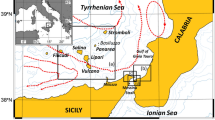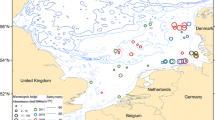Abstract
Hydrodynamic drift modeling was used to investigate the potential dispersion of Mnemiopsis leidyi from the Bornholm Basin in the Baltic Sea where it has been observed since 2007 further to the east and north. In the brackish surface layer dispersion is mainly driven by wind, while within the halocline dispersion is mainly controlled by the baroclinic flow field and bottom topography. Model runs showed that the natural spreading via deep water currents from the Bornholm Basin towards north and east is limited by topographic features and low advection velocities. Based on the information on ranges of salinity and temperature, which limit survival and reproduction of this ctenophore within the Baltic Sea, areas have been identified where the American comb jelly, M. leidyi could potentially survive and reproduce. While, we could show that M. leidyi might survive in vast areas of the northern Baltic Sea its reproduction is prevented by low salinity (<10 psu) and temperature (<12°C). Thus, due to the combined effect of low salinity and temperature, it is not probable that M. leidyi could establish permanent populations in the central or northern Baltic Sea. However, it seems that in the southern parts of the Baltic Sea environmental conditions are suitable for a successful reproduction of M. leidyi.






Similar content being viewed by others
References
Baker LD, Reeve MR (1974) Laboratory culture of the lobate ctenophore Mnemiopsis mccradyi with notes on feeding and fecundity. Mar Biol 26:57–62
Begon M, Harper JL, Townsend CR (1990) Ecology—individuals, populations and communities. Blackwell Science, Massachusets
Bergström S, Carlsson B (1994) River runoff to the Baltic Sea: 1950–1990. Ambio 23:280–287
Breitburg DL, Adamack A, Rose KA, Kolesar SE, Decker MB, Purcell JE, Keister JE, Cowan JH (2003) The pattern and influence of low dissolved oxygen in the Patuxent River, a seasonally hypoxic estuary. Estuaries 26:280–297
Costello JH, Sullivan BK, Gifford DK, Van Keuren D, Sullivan LJ (2006) Seasonal refugia, shoreward thermal amplification, and metapopulation dynamics of the ctenophore Mnemiopsis leidyi in Narragansett Bay, Rhode Island. Limnol Oceanogr 51:1819–1831
Faasse MA, Bayha KM (2006) The ctenophore Mnemiopsis leidyi A. Agassiz 1865 in coastal waters of the Netherlands: an unrecognized invasion? Aquat Invasions 1:270–277
Fuentes VL, Angel DL, Bayha KM, Atienza D, Edelist D, Bordehore C, Gili J-M, Purcell JE (2010) Blooms of the invasive ctenophore, Mnemiopsis leidyi, span the Mediterranean Sea in 2009. Hydrobiologia 645:23–37
Gollasch S, Leppäkoski E (2007) Risk assessment and management scenarios for ballast water mediated species introductions into the Baltic Sea. Aquat Invasions 2:313–340
Gorokhova E, Lehtiniemi M, Viitasalo-Frösén S, Haddock SHD (2009) Molecular evidence for the occurrence of ctenophore Mertensia ovum in the northern Baltic Sea and implications for the status of the Mnemiopsis leidyi invasion. Limnol Oceanogr 54(6):2025–2033
Hansson HG (2006) Ctenophores of the Baltic and adjacent Seas–the invader Mnemiopsis is here!. Aquat Invasions 1(4):295–298
Haslob H, Clemmesen C, Schaber M, Hinrichsen HH, Schmidt JO, Voss R, Kraus G, Köster FW (2007) Invading Mnemiopsis leidyi as a potential threat to Baltic fish. Mar Ecol Prog Ser 349:303–306
Hinrichsen HH, Lehmann A, St. John MA, Brugge B (1997) Modelling the cod larvae drift in the Bornholm Basin in summer 1994. Cont Shelf Res 17(14):1765–1784
Hinrichsen HH, Lehmann A, Möllmann C, Schmidt JO (2003) Dependency of larval fish survival on retention/dispersion in food limited environments: the Baltic Sea as a case study. Fish Oceanogr 12(4/5):425–433
Huwer B, Paulsen MR, Riisgård HU, Haslob H (2008) Abundance, horizontal and vertical distribution of the invasive ctenophore Mnemiopsis leidyi in the central Baltic Sea, November 2007. Aquat Invasions 3:113–124
Ivanov VP, Kamakin AM, Ushivtzev VB, Shiganova T, Zhukova O, Aladin N, Wilson SI, Harbison GR, Dumont HJ (2000) Invasion of the Caspian Sea by the comb jellyfish Mnemiopsis leidyi (Ctenophora). Biol Invasions 2:255–258
Janas U, Zgrundo A (2007) First record of Mnemiopsis leidyi A. Agassiz, 1865 in the Gulf of Gdańsk (southern Baltic Sea). Aquat Invasions 2(4):450–454
Javidpour J, Sommer U, Shiganova T (2006) First record of Mnemiopsis leidyi A. Agassiz 1865 in the Baltic Sea. Aquat Invasions 1(4):299–302
Javidpour J, Molinero JC, Lehmann A, Hansen T, Sommer U (2009) Annual assessment of the predation of Mnemiopsis leidyi in a new invaded environment, the Kiel Fjord (Western Baltic Sea): a matter of concern? J Plankton Res 31(7):729–738
Kolesar SE, Breitburg DL, Purcell JE, Decker MB (2010) Effects of hypoxia on Mnemiopsis leidyi, ichthyoplankton and copepods: clearance rates and vertical habitat overlap. Mar Ecol Prog Ser 411:173–188
Kube S, Postel L, Honnef C, Augustin CB (2007) Mnemiopsis leidyi in the Baltic Sea–distribution and overwintering between autumn 2006 and spring 2007. Aquat Invasions 2:137–145
Lehmann A (1995) A three-dimensional baroclinic eddy-resolving model of the Baltic Sea. Tellus 47:1013–1031
Lehmann A, Hinrichsen HH (2000) On the wind driven and thermohaline circulation of the Baltic Sea. Phys Chem Earth Part B: Hydrol Oceans Atmos 25:183–189
Lehmann A, Javidpour J (2010) Potential pathways of invasion and dispersal of Mnemiopsis leidyi A. Agassiz 1865 in the Baltic Sea. Hydrobiologia 649(1):107–114. doi:10.1007/s/10750-010-0233-8
Lehmann A, Krauss W, Hinrichsen HH (2002) Effects of remote and local atmospheric forcing on circulation and upwelling in the Baltic Sea. Tellus 54A:299–316
Lehtiniemi M, Pääkkönen JP, Flinkman J, Katajisto T, Gorokhova E, Karjalainen M, Viitasalo S, Björk H (2007) Distribution and abundance of the American comb jelly (Mnemiopsis leidyi)—a rapid invasion to the northern Baltic Sea during 2007. Aquat Invasions 2(4):445–449
Leppäkoski E, Gollasch S, Olenin S (2002) Invasive aquatic species of europe. Distribution, impacts and management. Kluwer, Dordrecht
Leppäranta M, Myrberg K (2009) Physical oceanography of the Baltic Sea. Springer, Berlin
Lundberg M, Hop H, Eaine K, Gulliksen B, Falk-Petersen S (2006) Population structure and accumulation of lipids of Ctenophore Mertensia Ovum. Mar Biol 149:1345–1353
Molnar JL, Gamboa RL, Revenga C, Spalding MD (2008) Assessing the global threat of invasive species to marine biodiversity. Front Ecol Environ 6(9):485–492. doi:10.1890/070064
Novotny K, Liebsch KG, Dietrich R, Lehmann A (2005) Combination of sea-level observations and an oceanographic model for geodetic applications in the Baltic Sea. In: Sanso F (ed) A window on the future of geodesy. Vol. 128 of Springer Series of IAG Symposia. Springer, New York, pp 195–200
Occhipinti-Ambrogi A, Savini D (2003) Biological invasions as a component of global change in stressed marine ecosystems. Mar Pollut Bull 46:542–551
Ojaveer E, Lumberg A, Ojaveer H (1998) Highlights of zooplankton dynamics in Estonian waters (Baltic Sea). ICES J Mar Sci 55:748–755
Oliveira OMP (2007) The presence of the ctenophore Mnemiopsis leidyi in the Oslofjorden and considerations on the initial invasion pathways to the North and Baltic Seas. Aquat Invasions 2(3):185–189
Paavola M, Olenin S, Leppäkoski E (2005) Are invasive species most successful in habitats of low native species richness across European brackish water seas? Estuar Coast Shelf Sci 64:738–750
Purcell JE, Decker MB (2005) Effects of climate on relative predation by scyphomedusae and ctenophores on copepods in Chesapeake Bay during 1987–2000. Limnol Oceanogr 50(1):376–387
Purcell JE, Shiganova TA, Decker MB, Houde ED (2001) The ctenophore Mnemiopsis in native and exotic habitats: U.S. estuaries versus the Black Sea basin. Hydrobiologia 451:145–176
Reusch TBH, Bolte S, Sparwel M, Moss AG, Javidpour J (2010) Microsatellites reveal origin and gentic diversity of Eurasian invasions by one of the world’s most notorious marine invader, Mnemiopsis leidyi (Ctenophora). Mol Biol 19:2690–2699
Riisgård HU, Bøttiger L, Madsen CV, Purcell JE (2007) Invasive ctenophore Mnemiopsis leidyi in Limfjorden (Denmark) in late summer 2007—assessment of abundance and predation effects. Aquat Invasions 2:395–401
Roohi A, Kideys AE, Hashemian ASA, Pourgholam R, Fazli H, Khanari AG, Eker-Develi E (2010) Changes in biodiversity of phytoplankton, zooplankton, fishes and macrobenthos in the Southern Caspian Sea after the invasion of the ctenophore Mnemiopsis leidyi. Biol Invasions 12:2343–2361
Sarpe D, Grosskopf T, Javidpour J (2007) Mnemiopsis leidyi—analysis of an invader in the Kiel Fjord with focus on respiration and reproduction rate, 42nd European marine biology symposium, 27–32 August 2007, Kiel, Germany
Schaber M, Haslob H, Huwer B, Harjes A, Hinrichsen H-H, Köster FW, Storr-Paulsen M, Schmidt JO, Voss R (2011) The invasive ctenophore Mnemiopsis leidyi in the central Baltic Sea: seasonal phenology and hydrographic influence on spatio-temporal distribution patterns. J Plankton Res. doi:10.1093/plankt/fbq167
Schulz J, Möllmann C, Hirche H-J (2007) Vertical zonation of the zooplankton community in the Central Baltic Sea in relation to hydrographic stratification as revealed by multivariate discriminant function and canonical analysis. J Mar Syst 67:47–58
Shiganova T, Malej A (2009) Native and non-native ctenophores in the Gulf of Trieste, Northern Adriatic Sea. J Plankton Res 31:61–71
Shiganova T, Musaeva EI, Bulgakova YV, Mirzoyan ZA, Martynyuk MI (2003) Invaders ctenophores Mnemiopsis leidyi (A. Agassiz) and Beroe ovata Mayer 1912, and their influence on the pelagic ecosystem of the northeastern Black Sea. Biol Bull 2:180–190
Siferd TD, Conover RJ (1992) Natural history of ctenophores in the Resolute Passage area of the Canadian High Arctic with special reference to Mertensia ovum. Mar Ecol Prog Ser 86:133–144
Tendal OS, Jensen KR, Riisgård HU (2007) Invasive ctenophore Mnemiopsis leidyi widely distributed in Danish waters. Aquat Invasions 2(4):455–460
Vinogradov ME, Shushkina EA, Musayeva EI, Sorokin PY (1989) A new exotic species in the Black Sea: the ctenophore Mnemiopsis leidyi (Ctenophora: Lobata). Oceanology 29:220–224
Yazdani Foshtomi M, Abtahi B, Esmaili Sari A, Taheri M (2007) Ion composition and osmolarity of Caspian Sea ctenophore, Mnemiopsis leidyi, in different salinities. J Exp Mar Biol Ecol 352:28–34
Acknowledgments
We thank the crews of R/V Aranda and Polarfuchs for help during samplings. We thank two anonymous referees for fruitful comments on the manuscript, Mona Becherer for conducting the reproduction experiments, Hilkka Pellikka and Tarja Katajisto for drawing the TS-plots and Jan-Erik Bruun for the salinity and oxygen maps.
Author information
Authors and Affiliations
Corresponding author
Rights and permissions
About this article
Cite this article
Lehtiniemi, M., Lehmann, A., Javidpour, J. et al. Spreading and physico-biological reproduction limitations of the invasive American comb jelly Mnemiopsis leidyi in the Baltic Sea. Biol Invasions 14, 341–354 (2012). https://doi.org/10.1007/s10530-011-0066-z
Received:
Accepted:
Published:
Issue Date:
DOI: https://doi.org/10.1007/s10530-011-0066-z




